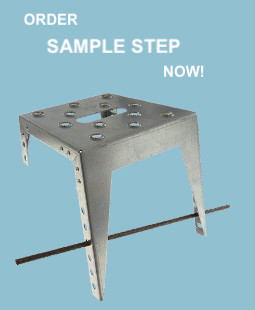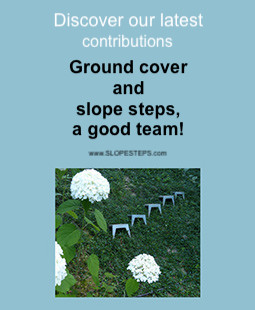Our FAQs
Why and for what do I need a slope step?
The slope steps allow you easier access to your slope, which is otherwise difficult to walk on. You can thus also access property areas that are difficult to access. The slope steps are flexible to use and easy to install. And - most importantly - you get good footing.
Can the steps also be ordered without the steel bar?
No, the steps are always delivered including a bar. This is necessary for safety reasons.
What step size do you recommend?
This is at the personal discretion of the user and depends on his or her needs. In general, however, the larger the tread surface, the better the footing. You can find more information here!
Which step type offers very good slip resistance?
The steps with punched serrated holes provide very good sure-footedness.
Which type of step is the lightest?
Up to which slope can the steps be used?
Depending on the step type, up to 45° slope ("Mini" step type). The step type "Midi" is suitable for slopes up to 40° and the step type "Maxi" for slopes up to 35°. For even steeper terrain, you can consider the extension bars!
Are the steps suitable for any surface?
The steps are best anchored in the soil. They are less suitable for soil that is penetrated with roots, such as forest soil. If in doubt, please carry out a test yourself in advance. Anchoring is not possible in stony ground or on stones.
Can the steps in the "galvanised steel" version be painted yourself?
The steps can be painted at any time. Due to the galvanisation, the steps offer good corrosion protection and a good base for painting. A primer is not absolutely necessary, but increases the durability of the applied lacquer. The lacquer should be suitable for outdoor use and have a coarse texture. However, due to the effects of the weather (snow, rain, frost, UV radiation, salt content in the air) as well as mechanical loads (footsteps, stones, soil, etc.), we would like to point out that no information can be given about the durability of the lacquer.
Can the steps also be ordered with a coloured coating?
Yes, that is possible! In the shop you will find coloured orderable steps to choose from, click here! Please click here for more detailed information!
Do you also offer stone and/or wood coverings for "The Decorative" slope steps?
Yes, this is possible on request. Please send us an eMail for this!
Many of your questions will be answered when watching the videos ....
What is the shape of the tread of the slope steps?
The shape is trapezoidal. The front side with the two long feet is wider than the rear side. See also the technical data.
How many slope steps do I need for my slope?
A "good, comfortable" walking is possible with a distance of 5 cm between the steps. On the homepage above (above the 3 videos) you will find a quantity calculator. Enter the slope length and select the step type, then you have an orientation how many steps you need.
Of course, this is also a bit of a "matter of taste". Someone who only very rarely has to use the stairs may say to himself, fewer steps with more spacing are enough for me.
What is the difference to the slope step?
The difference between the slope step and the walkway slab lies in the area of application. The slope step is used for the construction of a staircase on a slope, the walkway slab is more suitable for use on level or at most slightly ascending surfaces. In contrast to the slope step, the walkway slab has four equally short "feet".
Why are the step plates delivered without a steel bar?
The walkway slabs are usually laid on level ground, so it is not necessary to level the ground with the rod. However, if the terrain is sloping and/or uneven, steel bars can be ordered as an option. These can then be used to compensate for slight unevenness.
What size of walkway slab do you recommend?
This is at the personal discretion of the user and depends on his or her needs. In general, however, the larger the tread surface, the better the stance.
Are the walkway slabs suitable for any surface?
The best way to anchor the walkway slabs is in the soil. They are less suitable for soil that is penetrated with roots, such as forest soil. If in doubt, please carry out a test yourself in advance. Anchoring is not possible in stony ground or on stones.
What do I need a railing for?
You can use it to achieve additional safety for walking on the slope. You can also use it to demarcate certain areas.
Can ordered goods also be collected?
Yes, you can select "Collection" as the delivery method in the order process. Please arrange a collection date in good time beforehand.
Which products are in stock?
Find out which products are in stock here!
What do I need a knee pad for?
The knee pads are used when you want to kneel down on the slope steps, for example, when weeding slopes.
For what do I need an extension bar?
The extension bars are used when longer "feet" are required for anchoring the slope steps. This means that the slope steps (type Mini) can also be used in individual cases with a slope inclination steeper than 45 degrees.





 Lädt...
Lädt... 3 Person(s) like this
3 Person(s) like this